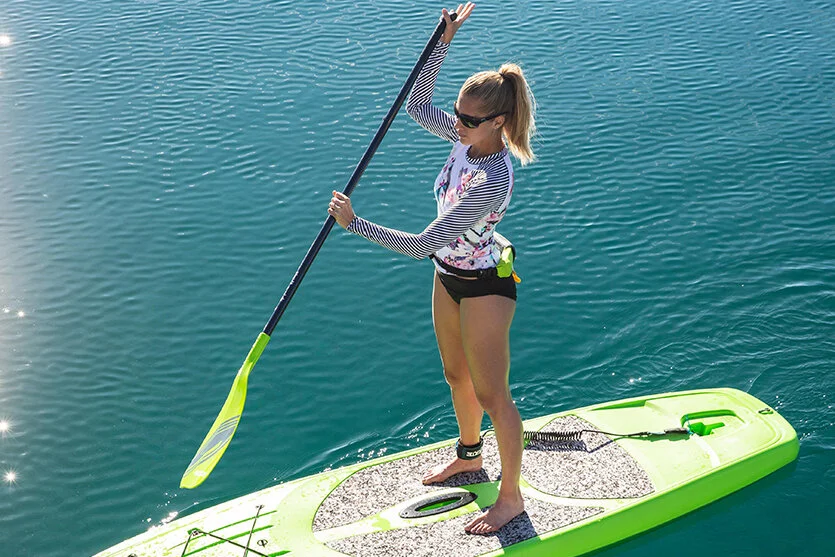Standup Paddle Boarding & Physical Therapy
Standup Paddle Boarding
A Physical Therapist’s Perspective
As we approach summer on Lake Washington, it is a great time to start dusting off the water toys and preparing yourself for a healthy and active season outdoors. You cannot help but notice people at the Perfect Wave on Lake Washington Boulevard as you commute home. Stand up paddle boarding (SUP) has become a common activity out on the lake and is a fun, low impact way for everyone from children to older adults to enjoy the water. SUP is a great way to stay active this summer, and can benefit muscular, balance, and cardiovascular systems.
Balance
Even in calm water, paddle boards are inherently unstable, and SUP requires good dynamic balance and core strength to react to both the perturbations from the paddling motions, as well as reacting to unexpected waves in the water. SUP lends itself well to novice and experienced paddlers as it is easy to modify your challenge level. If possible, try to learn on a beginner board that is a little larger, as it will be more stable and less affected by ripples or waves. The larger boards weigh more and will make it harder for long distance paddling, but it is worth it if you’re less experienced on open water. People who are newer to the activity may benefit from sitting on the board at first to reduce the balance challenge. You can then progress to kneeling, and finally standing as you become more comfortable on the board. Once standing, keep your feet at least hip distance apart, if not a little further to provide a wider base of support. This will reduce the balance demands and help improve your ability react to waves and paddling. Regardless of where you’re starting, try to keep a tall spine and engaged core. When asked about the most important things to remember for first time paddle boarders owner and Perfect Wave owner Bobby Arzadon said, “use your paddle for stability. Most beginners seem to attempt balancing with the paddle in the air.” He added, “Remember, rougher water conditions requires longer paddle strokes. This allows you to keep your paddle in the water longer, therefore having something to hold onto & balance easier.”
Form
As you get comfortable with standing while paddling, you can start paying attention to your form. While paddling, you will want to take longer strokes to improve speed and power by either reaching your arms further forward, or by hinging more deeply at your hips. Our hips and trunks have larger muscle mass and greater ability to generate power, so the hinge strategy is more efficient compared to reaching with your arms. Research has shown that inexperienced paddlers tend to utilize larger range of motion at the shoulder with a reaching motion, while experienced paddlers tend to use the hip hinge strategy. The reaching pattern is likely preferred initially because it will help you keep your center of mass over your base of support, whereas hinging will create a larger deviation in your center of mass, which will increase the overall balance demands. So, people new to paddle boarding tend to complete the reaching strategy that helps keep center mass more stable. However, learning and practicing the hip hinge strategy is important to reduce risk of injury to the shoulder, and allow you to travel faster by generating power from your core and hips.1,2
How to stay healthy with a new activity:
A common complaint among beginner paddle boarders is the demand it places on your feet. Our feet provide huge amounts of information to our brain about balance and where our body is in space. On a paddle board, our feet are working overtime and may respond by aching or cramping. It can be helpful to wear water shoes while you’re paddling, such as Tevas, Chacos, or Keens, as most of these active water sandals have some degree of arch support, which can be helpful both for improving balance and reducing cramping and soreness in the feet. Perfect Wave owner Bobby Arzadon adds, “most new paddlers, always feel it in the legs & butt. Especially the next day. The most irritation would probably be on the knees from kneeling so much.”
Once you get the basics, SUP can be a great activity for strengthening core and balance. It has been shown that individuals who paddle consistently tend to have better endurance for lumbopelvic extensors, an important muscle group that is frequently underdeveloped in individuals with low back pain.
While paddle boarding has relatively low rates of injury, shoulders are typically the most frequently injured part of the body, followed by low back and elbow. The main mechanism of injury is through endurance paddling with poor form or inadequate training leading up to the activity. Other injuries can occur by falling and hitting the board, sprint paddling, or hitting the lake/ocean floor when paddling in shallow water. Our physical therapists at Lake Washington Physical Therapy can help you reduce your risk of injury by assessing range of motion, strength, and endurance, as well as provide individualized strengthening and/or mobility programs.
Remember, when you are on the water safety is the most important factor:
Personal Flotation Device Options for Stand Up Paddleboarders
Safety should always be a top priority when heading out on the water. Discover what type of personal flotation device you should wear.
Personal flotation devices (PFDs) are an essential for every boarder. They are one of the most important pieces of safety equipment for water activities, like stand up paddleboarding. In fact, in most places, it’s now required by law to wear a PFD when on your paddleboard.
There are two popular types of PFDs from which to choose: life vests and inflatables.
LIFE VESTS
INFLATABLES
No matter what your experience level and which PFD you decide is best for you, make sure to wear it during your next stand up paddleboard excursion. You never know what you will experience on the water.
AUTHOR:
Kerri Smith, PT, DPT, CFSC
LWPT Kirkland Physical Therapist
CONTRIBUTORS:
Dr. Jonathan Hall, MD
ProOrtho Orthopedic Surgeon
Ben Wobker, PT, MSPT, CSCS, CFSC, SFMA
Founder & Director Lake Washington Physical Therapy
References:
1. Schram B, Furness J, Kemp-Smith K, et al. A biomechanical analysis of the stand-up paddle board stroke: a comparative study. PeerJ. 2019;7:e8006. Published 2019 Nov 1. doi:10.7717/peerj.8006
2 . Castañeda-Babarro A, Santos-Concejero J, Viribay A, Gutiérrez-Santamaría B, Mielgo-Ayuso J. The Effect of Different Cadence on Paddling Gross Efficiency and Economy in Stand-Up Paddle Boarding. Int J Environ Res Public Health. 2020;17(13):4893. Published 2020 Jul 7. doi:10.3390/ijerph17134893







